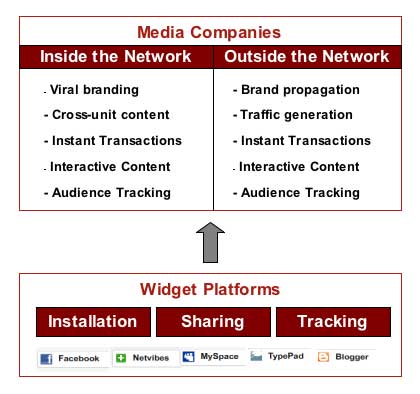Everyone knows that widgets are the new black. They are cool, they are slick, they are playful.
Cool and fun is one thing, but business is another. We are seeing an increasing number of media companies
and publishers turning to widgets. But why? What is it that media giants expect from these microchunks
of their content?

Apparently a lot. Media companies see widgets as an important new method of reaching audiences both inside
and outside their domains. It seems that widgets cover array of tasks ranging from brand propagation to
instant transactions and customer tracking. In this post we will take a look at how web widgets have evolved
from cool, viral toys of self-expression to important big media tools.
The Origin of Widgets
The rise of widgets was caused by several factors including the adoption of RSS, the expansion of the blogosphere,
growth of social networks, fashion of self-expression and the democratization of the web at large.
Originally, the goal of widgets was to simply deliver a miniaturized version of a specific piece of content
outside of the primary web site. A classic early widget is the Flickr badge, which allowed users
to show a preview of their photos. Clicking on the badge would lead to the Flickr user’s profile page with
all the user’s photos.

In a way, this type of widget is similar to affiliate links, except instead of the payoff being a lead/sale,
the badge owner received an ego boost whenever people looked at and commented on his or her profile.
The combination of the social dimension, the cool factor and self-expression made such widgets work
and they spread quickly on blogs and social network profiles.
Widget Platforms
Once the web widgets became popular, two major widget management platforms launched: Widgetbox and Clearspring.
Both platforms share a goal of helping spread and install widgets all over the web, but thier approach is
fundamentally different. Widgetbox is essentially a marketplace for widget consumers and widget developers.
Developers register with the site, then configure and submit their widgets to the gallery. Users can browse the widgets by
popularity or topic and then use an automated installer to get the widget set up on their blog or social network profile.
You can find more Read/WriteWeb coverage Widgetbox in this post.

Clearspring’s approach is different, focusing on widget developers and widget syndication, rather than being a portal for widgets.
Unlike Widgetbox, Clearspring does not have a browsable gallery, instead they offer API for developers to
use, which wraps the widget into a container that allows Clearspring to track the usage of the widget, handles installation
and offers a viral “Grab this” button (Widgetbox also offers tracking and a similar “Grab this” function).
Clearspring lets the developer of the widget decide how and where to offer the widget to the users.
Recently, Clearspring announced a few major deals with media companies, including the deal with NBC, which
we covered in this post.
Media Companies Get Widgets
So what is so compelling about widgets for companies like NBC? There is an opportunity to leverage widgets
both inside and outside the network. Inside the network, companies strive for audience retention and page views. Audience retention is complicated because readers have a myriad of choices these days and ever shorter attention spans.
Widgets, being typically interesting and playful, offer a way for companies to engage users with their content.
The same information presented inside the widget instead of on a plain web page is likely to be more interesting to the user
and prompt further exploration, thus leading to more page views.

Outside of the network, the latest widgets promise to combine the power of brand propagation (advertising) with
interactive content and even transactions. Widgets are perceived different from advertising, because
they deliver utility, particularly if they have interactive content. For example, the Random House Books
widget that we recently covered on this site lets users search through the entire contents of the book and read
preview pages. The users get a lot for free with this widget, so they are less likely to mind the Random House
branding and more likely to see the widget as a useful tool.
Seeing the benefits of widgets, large media companies turn to platforms like Clearspring to handle the infrastructure.
The media companies focus on what to widgetize and why, while the platforms are focused on how to make the widget
viral, installable in as many destinations as possible, and how to track the widget usage. The comprehensive tracking
is absolutely essential, because it measures effectiveness and lets the publishers understand their audience.
Widget Standards
A major development in the history of widgets occured just this week; the W3C published a draft of the
first widget specification. The goal of this effort is to standardize how widgets are scripted, digitally signed,
secured, packaged and deployed in a way that is device independent, follows W3C principles, and is as
interoperable as possible with existing market-leading user agents on which widgets are run. The spec is very raw,
and mostly based on desktop widgets rather than their web cousins, but it is already showing the direction where the W3C thinks widgets should evolve.

The major theme in the spec is interoperability. This is a big pain right now for widget developers and platforms
because widgets are platform specific. The spec aims to solve this problem by introducing common container API.
This, in a lot of ways, is similar to Applet or Servlet Specifications widely used in Java Community. The spec
proposes that the API focuses on declaring the packaging and the authorship metadata of the widget, as well as letting the widget
know about its environment and user preferences.
Overall it is an ambitious effort and will require a lot of community involvement and vendor cooperation.
The good news is that if this spec gets widely adopted the widget development will be much more fluid.
And this, will no doubt, lead to major growth in the widgetsphere.
Conclusion
Over the past few years widgets have gained wide acceptance as permanent citizens of the web.
Social widgets are continuing to grow and have become basically a standard feature,
since most social sites have them. We are also witnessing growth in widgets coming from large media companies,
as they recognize that widgets offer a unique marketing and revenue opportunity.
Because big media companies are jumping into the widget space, we expect to see the development of
richer, more interactive widgets. It is not clear at this point how long it will take to flash out the W3C widget specification completely,
and it is even less clear if/when it will get adopted. However, we expect that before that happens
platforms like Widgetbox and Clearsping will be adopted major widget destinations and platforms, including WordPress.
For more Read/WriteWeb Widget coverage check out these excellent posts by David Lenehan
and Graeme Thickins.
What is your take on widget growth? Please share links to your favorite widgets in the comments below.









